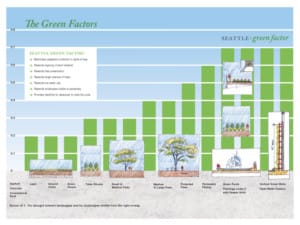Seattle Green Factor
Seattle was the first U.S. city to adopt a green area ratio (GAR), known there as the Seattle Green Factor (SGF). The city describes the SGF as a “score-based code requirement that increases the amount and improves the quality of landscaping in new development.” It aims to manage stormwater runoff, aesthetically enhance neighborhoods, and improve habitat for birds and beneficial insects.
A green area ratio, an alternative an approach requiring on-site mitigation, encourages the layered use of a range of mechanisms for stormwater capture. It provides real estate developers with a menu of options for compliance with green infrastructure and stormwater capture requirements.
Seattle adopted the SGF in 2006 and expanded the program in 2009, with the priorities being livability, ecosystem services, and climate change adaptation. Fife, Washington, a suburb of Tacoma near Seattle, also adopted a green factor as part of a low-impact development ordinance in 2009.
To qualify for permits, development projects in Seattle must achieve a minimum SGF score determined by zoning, with different standards set for commercial and residential properties. To achieve the score, developers may choose from a menu of options that award points—including rain gardens, native landscaping, vegetated walls, green roofs, and food gardens. The points are weighted by green infrastructure size, functionality, and aesthetics, with the total divided by the parcel size to create the SGF score. The system encourages the layered use of different stormwater mechanisms to increase absorption capacity and create rich aesthetics that support how new developments look and function. Landscaping in the public right-of-way is considered with landscaping on the site itself, and bonus points are awarded for landscape aspects visible to the public.
According to the American Society of Landscape Architects, “because SGF significantly raises the bar for landscaping in affected zones, landscape design now starts in the initial stages of site planning, allowing more collaboration between design professionals; the resulting landscapes are more attractive and better integrated into site programs and amenity areas.”
Washington, D.C.’s GAR system, which is very similar to Seattle’s SGF, applies to all new buildings that require a certificate of occupancy as well as any renovations with construction costs that exceed 100 percent of the building value within a one-year period.
Seattle’s Green Factor establishes a score for different types of green infrastructure; properties must meet a minimum score tied to the lot’s zoning. (City of Seattle)
Adapted from the 2017 ULI publication Harvesting the Value of Water: Stormwater Green Infrastructure and Real Estate.
